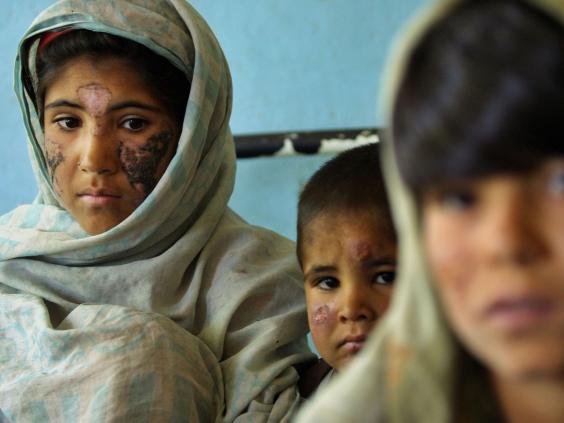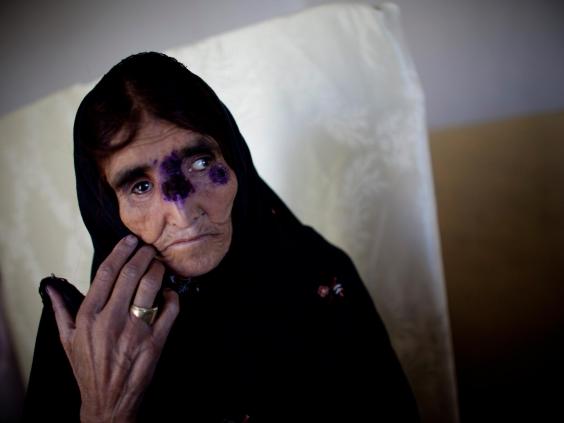Cutaneous leishmaniasis: Disfiguring tropical disease sweeps across Middle East
Cutaneous leishmaniasis, a disease transmitted through sand flies causes horrible open sores as well as disfiguring skinlesions

A disfiguring tropical disease is sweeping across the Middle East as a combination of heavy conflict and a breakdown of health care facilities in Isis-occupied areas leaves swathes of people vulnerable to the illness.
Cutaneous leishmaniasis is caused by a parasite in the blood stream transmitted through sand fly bites. The disease can result in horrible open sores as well as disfiguring skin lesions, nodules or papules.
Leishmaniasis has been endemic in Syria for centuries and was once commonly known as the “Aleppo evil”. However, as Syria’s civil war continues the resulting refugee crisis has triggered a catastrophic outbreak of the disease.

Children suffering from Cutaneous Leishmaniasis, a disfiguring and disabling skin disease (Getty Images )
Research published on Thursday in the scientific journal PLOS has found the disease is now affecting hundreds of thousands of people living in refugee camps or trapped in conflict zones. A similar situation may also be unfolding in eastern Libya and Yemen.
“We're seeing lots of diseases, including leishmaniasis in these conflict zones and we need to ring-fence them or risk another situation like Ebola out of the conflict zones in West Africa in 2014,” Peter Hotez, dean of the US National School of Tropical Medicine, US Science Envoy to the Middle East, and lead author of the PLOS research told the Digital Journal.

A woman receives treatment for a tropical skin disease (Getty Images )
Syria’s healthcare system has been devastated by years of conflict.In 2015 it was reported that more than half of the public hospitals in the country – previously a regional leader in healthcare – were closed or only partially functioning, leaving some patients forced to travel up to 100 miles to the nearest hospital.
In Syria, the number of leishmaniasis cases reported to the Ministry of Health doubled from 23,000 before the start of the civil war in 2011 to 41,000 in 2013, according to the PLOS research.
Neighbouring countries, which have received millions of refugees are also reporting many leishmaniasis cases. In Lebanon, cases rose to 1,033 in 2013 from six in the previous 12 years. Hundreds of cases have also been reported in Turkey and Jordan.
Turkey's two million Syrian refugees
According to scientists, eastern Libya has also reported increasing numbers of leishmaniasis. In Yemen, an estimated 10,000 new cases are reported every year. With Yeminis migrating to Saudi Arabia, concerns have been raised the disease may spreadfurther.
Dr Waleed Al-Salem, of the Liverpool School of Tropical Medicine, told MailOnline: “It's a very bad situation. The disease has spread dramatically in Syria, but also into countries like Iraq, Lebanon, Turkey and even into southern Europe with refugees coming in.
“There are thousands of cases in the region but it is still underestimated because no one can count the exact number of people affected.
“When people are bitten by sand flies - which are tiny and smaller than a mosquito - it can take anything between two to six months to have the infection.
Play
0:00
/
0:00
Fullscreen
Mute
Share
UN seeks Syria aid access as civilians risk starvation
“Someone might have picked it up in Syria but then they may have fled into Lebanon or Turkey, or even into Europe as they seek refuge.
“Prior to the outbreak of war there was good control of diseases, parasites and sand flies but when the conflict started no one cared, conditions worsened and the health system broke down, which has created an ideal environment for disease outbreaks.”
Cutaneous leishmaniasis is one of 17 tropical diseases categorized by
WHO as “neglected”. The organisation says greater awareness of the disease, better monitoring, training for clinicians and vector control could go some way to halting the epidemic.




No comments:
Post a Comment